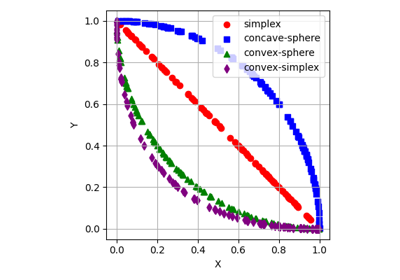generate_ndset#
- moocore.generate_ndset(n, d, /, method, *, seed=None, integer=False)[source]#
Generate a random set of
nmutually nondominated points of dimensiondwith the shape defined bymethod.When
integer=False(the default), the points are generated within the hypercube \((0,1)^d\) and can be scaled to another range usingnormalise(). Otherwise, points are scaled to a non-negative integer range that keeps the points mutually nondominated.- Parameters:
n (
int) – Number of rows in the output.d (
int) – Number of columns in the output.method (
str) – Method used to generate the random nondominated set. See the Notes below for more details.seed (
int|Generator|None, default:None) – Either an integer to seednumpy.random.default_rng(), Numpy default random number generator (RNG) or an instance of a Numpy-compatible RNG.Noneuses the equivalent of a random seed (seenumpy.random.default_rng()).integer (default:
False) – IfTrue, return integer-valued points.
- Returns:
ndarray– A numeric matrix of size \(n \times d\) containing nondominated points.
Notes
The available methods are:
"simplex","linear"or"L": Uniformly samples points on the standard simplex."concave-sphere","sphere"or"C": Uniformly samples points on the positive orthant of the hyper-sphere (concave for minimisation)."convex-sphere"or"X": Equivalent to1 - generate_ndset(..., method="concave-sphere"), which is convex for minimisation problems."convex-simplex": Equivalent togenerate_ndset(..., method="concave-sphere") ** 4, which is convex for minimisation problems. Such a set cannot be obtained by any affine transformation of a subset of the hyper-sphere.
Method
"simplex"uniformly samples points on the standard \((d-1)\)-simplex defined by \(\{\vec{x}\in \mathbb{R}_+^d : \sum_{i=1}^d x_i = 1\}\). This shape of nondominated set is also called"linear"in the literature [1]. Each point \(\vec{z} \in (0,1)^d \subset \mathbb{R}^d\) is generated by sampling \(d\) independent and identically distributed values \((x_1,x_2, \dots, x_d)\) from the exponential distribution, then dividing each value by the l1-norm of the vector, \(z_i = x_i / \sum_{i=1}^d x_i\) [2]. Values sampled from the exponential distribution are guaranteed to be positive.Sampling from either the standard normal distribution [3] or the uniform distribution [1] does not produce a uniform distribution when projected into the simplex.
Method
"concave-sphere"uniformly samples points on the positive orthant of the hyper-sphere, which is concave when all objectives are minimised. Each point \(\vec{z} \in (0,1)^d \subset \mathbb{R}^d\) is generated by sampling \(d\) independent and identically distributed values \(\vec{x}=(x_1,x_2, \dots, x_d)\) from the standard normal distribution, then dividing each value by the l2-norm of the vector, \(z_i = \frac{|x_i|}{\|\vec{x}\|_2}\) [4]. The absolute value in the numerator ensures that points are sampled on the positive orthant of the hyper-sphere. Sampling from the uniform distribution [1] does not result in a uniform sampling when projected onto the surface of the hyper-sphere.Method
"convex-sphere"is equivalent to1 - generate_ndset(..., method="concave-sphere"), which is convex for minimisation problems. It corresponds to translating points from the negative orthant of the hyper-sphere to the positive orthant.Method
"convex-simplex"is equivalent togenerate_ndset(..., method="concave-sphere")**4, which is convex for minimisation problems. The corresponding surface is equivalent to a simplex curved towards the origin.References
Examples
>>> moocore.generate_ndset(5, 3, "simplex", seed=42) array([[0.33742524, 0.32787894, 0.33469582], [0.15382676, 0.047522 , 0.79865124], [0.30561291, 0.67719985, 0.01718724], [0.47441115, 0.03192912, 0.49365973], [0.51684378, 0.11549762, 0.3676586 ]]) >>> moocore.generate_ndset(5, 3, "simplex", seed=42, integer=True) array([[21, 20, 21], [ 9, 3, 51], [19, 43, 1], [30, 2, 31], [33, 7, 23]]) >>> rng = np.random.default_rng(42) >>> moocore.generate_ndset(4, 2, "sphere", seed=rng) array([[0.28118049, 0.9596549 ], [0.62368072, 0.78167919], [0.83175713, 0.5551397 ], [0.37478326, 0.92711246]]) >>> moocore.generate_ndset(3, 5, "convex-sphere", seed=rng) array([[0.98843533, 0.41282763, 0.39468745, 0.46462554, 0.95454935], [0.37787475, 0.74198125, 0.52575586, 0.79648617, 0.47079199], [0.47186748, 0.96998408, 0.88885902, 0.5906188 , 0.26499673]]) >>> moocore.generate_ndset(4, 4, "convex-simplex", seed=rng) array([[1.50912692e-03, 8.90810874e-02, 4.06920896e-02, 2.12488882e-01], [6.92170773e-04, 1.12617206e-03, 1.33695589e-03, 8.16435071e-01], [1.26387422e-02, 3.18954020e-02, 2.03159622e-01, 6.66944487e-02], [2.27337966e-01, 2.35916000e-05, 6.97235603e-02, 6.46639006e-02]])
